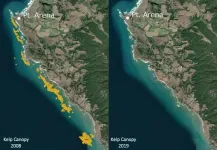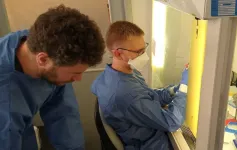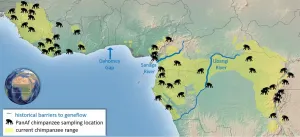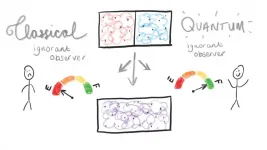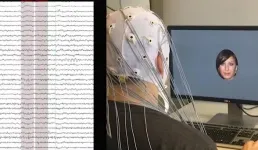Tracking proteins in the heart of cells
For the first time, a UNIGE team has been able to follow precisely the path taken by a protein within the cell, paving the way for the study of the transport and distribution network of vital elements necessary for its survival.
2021-03-05
(Press-News.org) In order to stay alive, the cell must provide its various organelles with all the energy elements they need, which are formed in the Golgi apparatus, its centre of maturation and redistribution of lipids and proteins. But how do the proteins that carry these cargoes - the kinesins - find their way and direction within the cell's "road network" to deliver them at the right place? Chemists and biochemists at the University of Geneva (UNIGE), Switzerland, have discovered a fluorescent chemical dye, making it possible for the first time to track the transport activity of a specific motor protein within a cell. A discovery to be read in the magazine Nature communication.
"It all started from a research that didn't go as planned," laughs Nicolas Winssinger, professor at the Department of Organic Chemistry of the Faculty of Science at UNIGE. "Initially, we wanted to develop a molecule that would make it possible to visualise the stress level of the cell, i.e. when it accumulates too much active oxygen species. During the experiment, the molecule did not work, but crystallised. Why did it crystallise? What were these crystals?"
Three hypotheses emerged as possible and the team reached out to Charlotte Aumeier, professor in the Department of Biochemistry of the Faculty of Sciences of the UNIGE to verify them. The first hypothesis suggested that crystallisation was due to the microtubules that polymerise. "Microtubules are small, rigid tubes that can grow or shrink and constitute the "road network" that allows molecules to move around the cell," explains Charlotte Aumeier. The second hypothesis made Golgi's apparatus responsible for this chemical reaction. The last possibility suggested that the crystals were the result of the small steps made by the kinesin proteins in the microtubules as they moved within the cell.
The biochemists' little thumb
To verify these different options, the UNIGE team joined forces with the National Institute of Health (NIH) in Bethesda (USA), which specialises in electron microscopy. "We first recreated microtubules that we purified, which takes 14 hours," explains Charlotte Aumeier. "For the kinesins, the motor proteins that move on microtubules and transport cargo, we isolated them from bacteria." The scientists then put together about 20 different mixtures containing the small molecule QPD, which is systematically present in the crystals, and observed which solution worked. "We wanted to know what was needed to form the crystals. The microtubules? The kinesin? Yet another protein?" asks Nicolas Winssinger.
Following various experiments, the team discovered that the formation of these crystals was caused by one of the 45 types of kinesin present in the cell. "With each small step that this kinesin protein takes on the microtubule, it uses energy that leaves a trace identified by the QPD molecule," continues the Geneva-based researcher. It is from this recognition that the crystals are formed. In this way, the crystals are chemically left behind by the passage of the kinesin, which can be tracked by scientists like a small thumb.
The opening of a new field of study
"Until now, it has not been possible to track a particular protein. With current techniques, we couldn't separate the individual kinesins, so we couldn't see which path they took precisely," continues Charlotte Aumeier. "Thanks to the development of our new chemical fluorescent dye, we can observe in detail how a protein behaves, which route it takes, its direction or even its preferred path." For the first time, scientists can visualise the walking path of motor proteins and study the fundamental question of the transport activity and distribution of cargoes in cells.
INFORMATION:
[Attachments] See images for this press release:
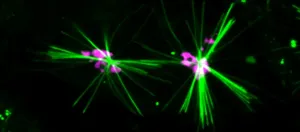
ELSE PRESS RELEASES FROM THIS DATE:
2021-03-05
More Antarctic meltwater is surfacing than was previously known, modifying the climate, preventing sea ice from forming and boosting marine productivity- according to new research from the University of East Anglia (UEA).
For the first time, researchers have been able to obtain full-depth glacial meltwater observations in winter, using instruments attached to the heads of seals living near the Pine Island Glacier, in the remote Amundsen Sea in the west of Antarctica.
The harsh environmental conditions in the Antarctic limit the use of most traditional observation systems, such as ships and airplanes, especially ...
2021-03-05
Researchers at Scripps Institution of Oceanography at UC San Diego examining 14 years of hospital admissions data conclude that the fine particles in wildfire smoke can be several times more harmful to human respiratory health than particulate matter from other sources such as car exhaust. While this distinction has been previously identified in laboratory experiments, the new study confirms it at the population level.
This new research work, focused on Southern California, reveals the risks of tiny airborne particles with diameters of up to 2.5 microns, about one-twentieth that of a human hair. These particles - termed PM2.5 - are the ...
2021-03-05
Satellite imagery shows that the area covered by kelp forests off the coast of Northern California has dropped by more than 95 percent, with just a few small, isolated patches of bull kelp remaining. Species-rich kelp forests have been replaced by "urchin barrens," where purple sea urchins cover a seafloor devoid of kelp and other algae.
A new study led by researchers at UC Santa Cruz documents this dramatic shift in the coastal ecosystem and analyzes the events that caused it. This was not a gradual decline, but an abrupt collapse of the kelp forest ecosystem in the aftermath of unusual ocean warming along the West Coast starting in 2014, part of a series of events that combined to decimate the kelp forests.
Published March 5 in Communications Biology, ...
2021-03-05
Quantitative real-time polymerase chain reaction (qPCR) is the most widely used diagnostic method to detect RNA viruses such as SARS-CoV-2. However, it requires expensive laboratory equipment and global shortages of reagents for RNA purification has increased the need to find simple but reliable alternatives. One alternative to the qPCR technology is RT-LAMP (reverse transcription loop-mediated isothermal amplification). This test amplifies the desired target sequences of the virus at a constant temperature, using minimal equipment compared to qPCR. In 2020, it was adapted to the detection of SARS-CoV-2. It was also shown that instead of a swab, which many people find unpleasant, it can be performed on gargle lavage samples.
First author Lukas Bokelmann and colleagues have now ...
2021-03-05
Researchers from the Pan African Programme: The Cultured Chimpanzee (PanAf) at the Max Planck Institute for Evolutionary Anthropology (MPI-EVA) and a team of international researchers, collected over 5000 fecal samples from 55 sites in 18 countries across the chimpanzee range over 8 years. This is by far the most complete sampling of the species to date, with a known location of origin for every sample, thus addressing the sampling limitations of previous studies. "Collecting these samples was often a daunting task for our amazing field teams. The chimpanzees were almost all unhabituated to human presence, so it took a lot of patience, skill and luck to find chimpanzee dung at each of the sites," explains ...
2021-03-05
Researchers have developed a new quantum version of a 150-year-old thermodynamical thought experiment that could pave the way for the development of quantum heat engines.
Mathematicians from the University of Nottingham have applied new quantum theory to the Gibbs paradox and demonstrated a fundamental difference in the roles of information and control between classical and quantum thermodynamics. Their research has been published today in Nature Communications.
The classical Gibbs paradox led to crucial insights for the development of early thermodynamics and emphasises the need to consider an experimenter's ...
2021-03-05
DUBLIN, Friday, 5 March 2021: RCSI researchers have discovered a new way to 'put the brakes' on excessive inflammation by regulating a type of white blood cell that is critical for our immune system.
The discovery has the potential to protect the body from unchecked damage caused by inflammatory diseases.
The paper, led by researchers at RCSI University of Medicine and Health Sciences, is published in Nature Communications.
When immune cells (white blood cells) in our body called macrophages are exposed to potent infectious agents, powerful inflammatory proteins ...
2021-03-05
New York, NY (March 5, 2021) - Overweight children who were exposed to lead in utero and during their first weeks of life have the potential for poorer kidney function in adulthood, according to an Icahn School of Medicine at Mount Sinai study published in Environment International in March.
The study found that children with high body mass indexes who had been exposed to lead had lower estimated glomerular filtration rate (eGFR), a measure of how well the kidneys are filtering or cleaning the blood. The researchers measured blood levels during mothers' pregnancy and later measured eGFR levels in the children when they were between 8 and 12 years old.
Decreased ...
2021-03-05
Researchers have succeeded in making an AI understand our subjective notions of what makes faces attractive. The device demonstrated this knowledge by its ability to create new portraits on its own that were tailored to be found personally attractive to individuals. The results can be utilised, for example, in modelling preferences and decision-making as well as potentially identifying unconscious attitudes.
Researchers at the University of Helsinki and University of Copenhagen investigated whether a computer would be able to identify the facial features we consider attractive and, based on this, create new images matching our criteria. The researchers used artificial intelligence to interpret brain signals and combined the resulting brain-computer interface with a ...
2021-03-05
Researchers from University of Houston and University of Bochum published a new paper in the Journal of Marketing that examines how variable compensation plans for salespeople can lead to lower health.
The study, forthcoming in the Journal of Marketing, is titled "Variable Compensation and Salesperson Health" and is authored by Johannes Habel, Sascha Alavi, and Kim Linsenmayer.
Sales compensation plans typically comprise a variable component. Variable compensation is issued on top of a base salary and the amount is contingent on performance. For example, a salesperson with an annual target salary ...
LAST 30 PRESS RELEASES:
[Press-News.org] Tracking proteins in the heart of cells
For the first time, a UNIGE team has been able to follow precisely the path taken by a protein within the cell, paving the way for the study of the transport and distribution network of vital elements necessary for its survival.
